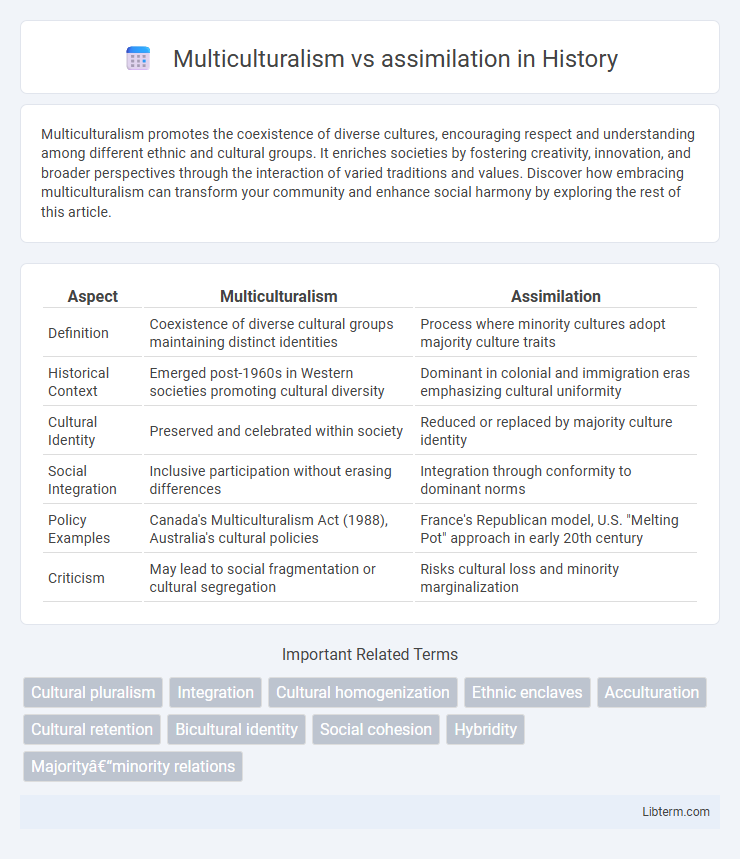Multiculturalism promotes the coexistence of diverse cultures, encouraging respect and understanding among different ethnic and cultural groups. It enriches societies by fostering creativity, innovation, and broader perspectives through the interaction of varied traditions and values. Discover how embracing multiculturalism can transform your community and enhance social harmony by exploring the rest of this article.
Table of Comparison
| Aspect | Multiculturalism | Assimilation |
|---|---|---|
| Definition | Coexistence of diverse cultural groups maintaining distinct identities | Process where minority cultures adopt majority culture traits |
| Historical Context | Emerged post-1960s in Western societies promoting cultural diversity | Dominant in colonial and immigration eras emphasizing cultural uniformity |
| Cultural Identity | Preserved and celebrated within society | Reduced or replaced by majority culture identity |
| Social Integration | Inclusive participation without erasing differences | Integration through conformity to dominant norms |
| Policy Examples | Canada's Multiculturalism Act (1988), Australia's cultural policies | France's Republican model, U.S. "Melting Pot" approach in early 20th century |
| Criticism | May lead to social fragmentation or cultural segregation | Risks cultural loss and minority marginalization |
Defining Multiculturalism and Assimilation
Multiculturalism emphasizes the coexistence of diverse cultural identities within a society, valuing the preservation of distinct languages, traditions, and customs. Assimilation involves the process by which individuals or groups adopt the dominant cultural norms, often leading to the reduction or loss of original cultural characteristics. Defining multiculturalism highlights inclusion and cultural pluralism, while assimilation centers on integration through cultural uniformity.
Historical Contexts of Cultural Integration
Multiculturalism emerged as a response to colonialism and migration patterns in the 20th century, promoting the coexistence of diverse cultural identities within a single society. Assimilation historically reflected nation-state-building efforts, particularly in countries like the United States and France, aiming to integrate immigrants into a dominant cultural framework. The contrasting approaches highlight ongoing debates over preserving ethnic heritage versus achieving social cohesion through uniform cultural norms.
Key Principles of Multiculturalism
Multiculturalism emphasizes the recognition and preservation of diverse cultural identities within a society, encouraging equal respect for all ethnic, religious, and linguistic groups. It promotes cultural pluralism, mutual respect, and the right to maintain individual cultural heritage while participating in the broader national community. Key principles include inclusivity, equality, and the protection of minority rights to foster social cohesion without demanding cultural uniformity.
Core Tenets of Assimilation
Assimilation emphasizes the core tenets of cultural integration, including adopting the dominant society's language, values, and norms to achieve social cohesion and reduce cultural conflicts. It promotes the idea that minority groups should gradually shed distinct cultural identities to become indistinguishable from the majority population. The focus on conformity and unity aims to create a homogeneous society with shared beliefs and practices.
Social Impact of Multicultural Policies
Multicultural policies promote social cohesion by recognizing and valuing cultural diversity, which enhances mutual respect and reduces ethnic tensions within communities. These policies support the inclusion of minority groups, leading to increased political participation and equitable access to resources. The positive social impact includes fostering a sense of belonging and identity, which contributes to overall societal stability and harmony.
Economic Outcomes of Integration Approaches
Multiculturalism promotes economic diversity by encouraging cultural expression and entrepreneurship within immigrant communities, often resulting in higher innovation and niche market development. Assimilation, emphasizing uniformity, may streamline workforce integration and reduce social barriers, potentially enhancing overall productivity and labor market participation. Studies indicate that balanced integration approaches fostering both cultural retention and economic inclusion yield the most sustainable economic outcomes.
Challenges of Assimilation in Modern Societies
Assimilation challenges in modern societies include the loss of cultural identity and the pressure to conform to dominant social norms, often leading to social alienation among minority groups. Language barriers and systemic discrimination further hinder effective integration, resulting in limited access to education, employment, and social services. These obstacles contribute to social fragmentation, increasing tensions between immigrant populations and host communities.
Multiculturalism and National Identity
Multiculturalism promotes the coexistence of diverse cultural identities within a nation, enriching the national identity by reflecting a mosaic of traditions, languages, and values. This approach fosters social inclusion and mutual respect, helping to build a dynamic and pluralistic national identity that evolves with its diverse population. National identity under multiculturalism is seen as a collective tapestry rather than a singular, homogeneous culture.
Case Studies: Successes and Failures Worldwide
Case studies reveal that multiculturalism in Canada fosters social cohesion and economic benefits through policies supporting cultural diversity and inclusion, while Australia's initial assimilationist approach faced criticism for marginalizing Indigenous populations, leading to policy shifts embracing multicultural values. In contrast, France's strict assimilation model challenges integration by enforcing uniform national identity, resulting in social tensions and ethnic disparities. Germany's evolution from assimilation to multiculturalism demonstrates improved immigrant integration and labor market outcomes, highlighting the complex balance between preserving cultural identity and promoting social unity.
Future Directions in Cultural Integration
Future directions in cultural integration emphasize dynamic multiculturalism that values diverse identities while fostering social cohesion and shared civic values. Policies promoting intercultural dialogue, inclusive education, and equitable economic participation enable communities to thrive amid globalization and migration trends. Technological advancements also facilitate virtual cultural exchanges, expanding opportunities for mutual understanding and hybrid identity formation.
Multiculturalism Infographic

 libterm.com
libterm.com